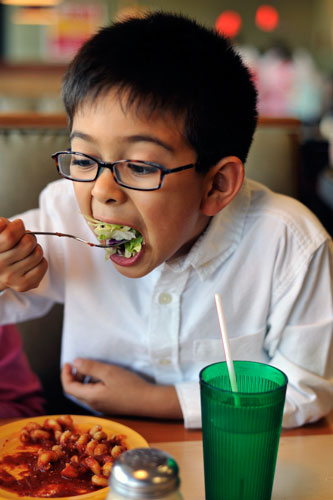“Of course I don’t believe in diets for kids,” she said. “It’s not about how much they eat – it’s about what you feed them!”
What I wish I’d said: “Trust me: trying to get kids to eat vegetables and settle for ‘healthy’ food, is a diet!”
Kids of all shapes and sizes eat vegetables.
Kids of all shapes and sizes eat fast food.
Kids of all shapes and sizes sneak around to overeat on “forbidden” food when it’s restricted.
Kids of all shapes and sizes eat what and eat as much as they need to grow in the way that is right for them when their grownups provide regular, appealing, sit-down meals and snacks and trust them (the kids) to do their jobs with eating.
I’d tried to give a pretty-good explanation about using the Satter Division of Responsibility in Feeding as a tool for helping parents concerned with their child’s weight. It went in one ear and out the other. The idea that some foods are slimming and others fattening is so set in stone—and so destructive—that it is very difficult to get past. After all, the health policy makers recommend the very same thing for weight management: Push fruits and vegetables, eat low-fat, restrict sugar.
It-doesn’t-work.
Dozens—hundreds—thousands—of experiments say it doesn’t work. Parents in my practice don’t need the experiments to know: They describe the misery of growing up hungry and ashamed of their longing for good-tasting, filling food. And they still feel obligated to do to their children what was done to them, despite their decades long battle with food and weight.
In my practice, I do my best to end the misery. “It’s not your job to determine what and how much your child eats,” I say. “Nor how their body turns out. That’s up to them and Mother Nature. Your job is having regular family meals and sit-down snacks made of food everyone enjoys. After that, it’s their job to determine whether to eat and how much.”
Then I put a name on what I just said: the Satter Division of Responsibility in Feeding. We work together to get enjoyable meals in place and to help them identify and stop their interference with what and how much their child eats. I am careful to treat all their food with respect and discourage pushing fruits and vegetables and other “healthy” food. In short, I help them all—parents and children alike—to discover the joy of eating.
Jillian Murphy ND. ESI Associate Graduate

